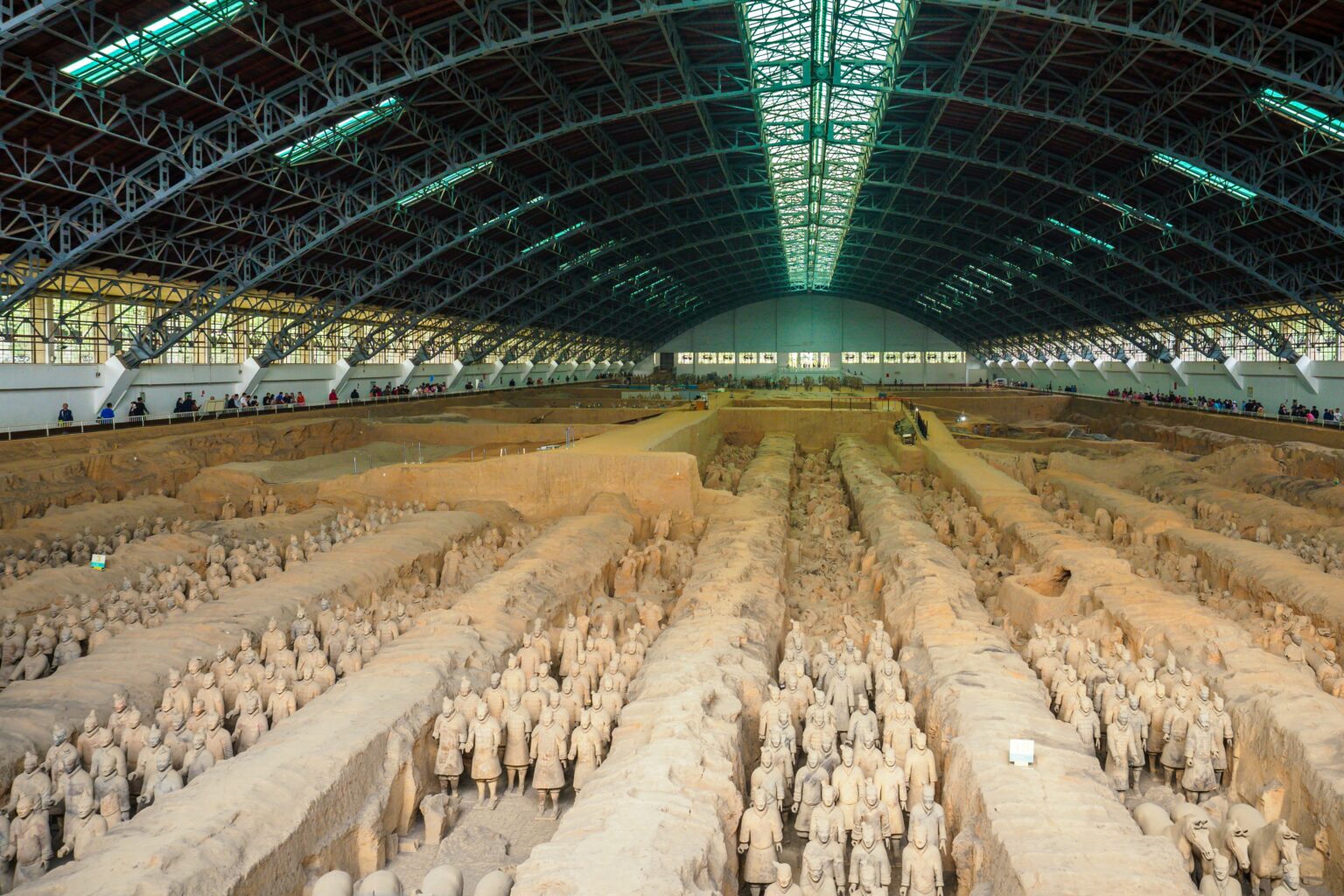The Terracotta Army, one of the world’s most enigmatic archaeological discoveries, astounds visitors with its awe-inspiring thousands of life-sized statues. Discovered in Xi’an, China, these ancient statues have a history that dates back over two millennia. This post delves into the magnificence and mysteries surrounding the Terracotta Army, examining their creation, artistic precision, historical significance, and the broader cultural context that led to their existence.
The Discovery and Historical Significance
In 1974, farmers near Xi’an discovered the first fragments of the Terracotta Army while digging a well. What they unearthed turned out to be an astounding archaeological site depicting an unprecedented ancient army. This led to the excavation of an expansive necropolis surrounding China’s first emperor, Emperor Qin Shi Huang.
More:Read About on Great Wall of China: World’s Greatest Architectural Marvels
Emperor Qin, known for unifying China and standardizing various aspects of life during his rule (221-210 BCE), commissioned the Terracotta Army as part of his elaborate mausoleum. The statues were intended to protect him in the afterlife and demonstrate his power and authority both in this life and the next. This monumental project involved over 700,000 laborers and took more than 40 years to complete.
Astounding Artistic Precision
The Terracotta Army’s unparalleled artistic precision is a testament to the skill and craftsmanship of the ancient artisans who created them. Each statue is unique, with distinct facial expressions, hairstyles, and clothing, showcasing the meticulous attention to detail. Surprisingly, no two statues are alike, emphasizing the individuality and diversity within the ancient Chinese military.
For instance, the soldiers, horsemen, archers, and chariots were meticulously modeled, resembling the actual soldiers serving in Emperor Qin’s army. The level of accuracy and realism is extraordinary, with intricate armor, weaponry, and even intricate braids depicted on the statues.
The Lingering Mysteries
Despite decades of exploration and research, numerous intriguing mysteries still haunt the Terracotta Army. One major question continues to puzzle experts: Why was this vast army constructed?
It is theorized that the Terracotta Army served not only as a funerary guardian but also to demonstrate the emperor’s power and authority. However, many aspects remain uncertain, such as why certain statues appear to have been intentionally damaged and who precisely the statues represent.
Additionally, advancements in technology have allowed researchers to delve into further breakthrough discoveries. Ground-penetrating radar and satellite imagery have revealed the existence of numerous other pits in the surrounding area, potentially hinting at an even larger army yet to be unearthed.
The coloration of the statues is another mystery. The statues were originally brightly painted, with evidence of pigments still visible on some fragments.
However, as soon as the statues are exposed to air, the paint rapidly flakes off, leaving the statues in their current terracotta hue. Researchers are working tirelessly to develop techniques to preserve the paint on newly excavated statues.
Cultural Context and Modern Significance
The Terracotta Army not only astounds us with its ancient beauty but also symbolizes the rich history and cultural heritage of China. The creation of this magnificent army reflects the belief in the afterlife prevalent in ancient Chinese society. Furthermore, it serves as a testament to the sophistication and engineering prowess of the Qin Dynasty.
More: Wanted to download Odisha Magazines, visit here
Today, the Terracotta Army has become a symbol of pride for China, attracting millions of international visitors each year. Its inclusion in the list of UNESCO World Heritage Sites further solidifies its global significance as an archaeological treasure.
Conclusion
The Terracotta Army’s enigmatic statues are an undeniable testament to the ancient world’s grandeur. From the moment they were unearthed in Xi’an, these life-sized statues have captured the imagination of people worldwide, while also leaving us with unanswered questions about their creation and purpose. The sheer scale, artistic precision, and historical significance of the Terracotta Army make it an unparalleled archaeological wonder that continues to inspire and enthrall visitors today. Whether one stands before the row upon row of silent soldiers, the powerful horsemen, or the intricately crafted archers and chariots, witnessing the Terracotta Army firsthand is a captivating experience that echoes the rich cultural heritage of China and the timeless mysteries surrounding an ancient civilization.
FAQ For Terracotta Army’s Enigmatic Statues – A Timeless Marvel
What is the Terracotta Army?
The Terracotta Army is a collection of terracotta sculptures depicting the armies of Qin Shi Huang, the first Emperor of China. These statues were buried with the emperor to protect him in the afterlife.
Where is the Terracotta Army located?
The Terracotta Army is located in the city of Xi’an, in the Shaanxi province of China.
How many statues are in the Terracotta Army?
It is estimated that there are over 8,000 soldiers, 130 chariots with 520 horses, and 150 cavalry horses in the Terracotta Army.
When were the Terracotta Army statues discovered?
The Terracotta Army was discovered in 1974 by local farmers digging a well near the tomb of Qin Shi Huang.
What makes the Terracotta Army statues so remarkable?
The statues are incredibly detailed and each one has distinct facial features and expressions. They provide insight into the military organization of ancient China.
Can visitors see the Terracotta Army up close?
Yes, visitors can see the Terracotta Army up close at the Museum of the Terracotta Warriors and Horses in Xi’an.
Are there any other attractions near the Terracotta Army site?
Yes, there are other attractions near the Terracotta Army site including the Mausoleum of the First Qin Emperor and the Huaqing Hot Springs.
Is there a recommended time to visit the Terracotta Army?
The best time to visit the Terracotta Army is during the cooler months of spring and autumn to avoid the hot summers and crowded tourist seasons.
Can I take photographs at the Terracotta Army site?
Yes, visitors are allowed to take photographs at the Terracotta Army site, but flash photography may be prohibited in some areas to preserve the statues.

